[1]
I.A. Ibrahim, F.A. Mohamed, E.J. Lavernia, Particulate reinforced metal matrix composites-a review, J Mater Sci, 26(1991) 1137-1156.
DOI: 10.1007/bf00544448
Google Scholar
[2]
D.J. Lloyd, Particle reinforced aluminium and magnesium matrix composites, Int Mater Rev, 39(1994) 1-23.
Google Scholar
[3]
D.B. Miracle, Metal matrix composites - From science to technological significance, Compos Sci Technol, 65(2005) 2526-2540.
DOI: 10.1016/j.compscitech.2005.05.027
Google Scholar
[4]
S.C. Tjong, Z.Y. Ma, Microstructural and mechanical characteristics of in situ metal matrix composites, Mat Sci Eng R, 29(2000) 49-113.
Google Scholar
[5]
J.M. Torralba, C.E. Da Costa, F. Velasco, P/M aluminum matrix composites: an overview, J Mater Process Tech, 133(2003) 203-206.
Google Scholar
[6]
E. Pagounis, V.K. Lindroos, Processing and properties of particulate reinforced steel matrix composites, Mat Sci Eng A-Struct, 246(1998) 221-234.
DOI: 10.1016/s0921-5093(97)00710-7
Google Scholar
[7]
X.C. Tong, A.K. Ghosh, Fabrication of in situ TiC reinforced aluminum matrix composites, J Mater Sci, 36(2001) 4059-4069.
Google Scholar
[8]
L. Lu, M.O. Lai, Y. Su, H.L. Teo, C.F. Feng, In situ TiB2 reinforced Al alloy composites, Scripta Mater, 45(2001) 1017-1023.
DOI: 10.1016/s1359-6462(01)01128-9
Google Scholar
[9]
L. Lu, M.O. Lai, H.Y. Wang, Synthesis of titanium diboride TiB2 and Ti-Al-B metal matrix composites, J Mater Sci, 35(2000) 241-248.
Google Scholar
[10]
J. Zhang, R.J. Perez, E.J. Lavernia, Effect of SiC and graphite particulates on the damping behavior of metal matrix composites, Acta Metallurgica Et Materialia, 42(1994) 395-409.
DOI: 10.1016/0956-7151(94)90495-2
Google Scholar
[11]
J. Zhang, R.J. Perez, E.J. Lavernia, Dislocation-induced damping in metal matrix composites, J Mater Sci, 28(1993) 835-846.
DOI: 10.1007/bf01151266
Google Scholar
[12]
Deonath, R. Narayan, P. Rohatgi, Damping capacity, resistivity, thermal expansion and machinability of aluminium alloy-mica composites, J Mater Sci, 16(1981) 3025-3032.
DOI: 10.1007/bf00540308
Google Scholar


